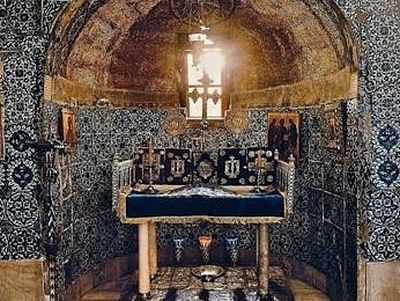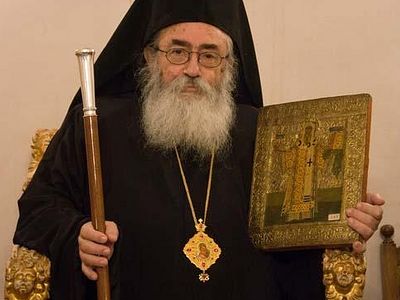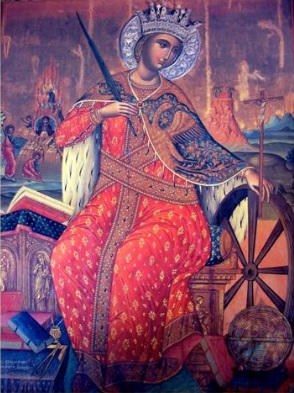
A graceful silver ring bearing the monogram of Saint Catherine of Alexandria betokens the most ancient of societies, its earliest membership predating Christianity itself. Presented to pilgrims at Mount Sinai by the monks of St. Catherine's Greek Orthodox Monastery, the ring signifies pilgrimage to the Holy Mountain – a custom whose preservation in the memory of local populations led the earliest ascetics to settle at the Burning Bush. Saint Helena visited in the fourth century, and others followed, enthusiastically noting the hospitality that rewarded arduous journey through the desert by camel caravan.
“Behold! A great number of monks and hermits beyond counting came out to meet us,” recounted a sixth century pilgrim in one of the earliest surviving Sinai travelogues, “carrying crosses and singing psalms. They lay down upon the ground and made obeisance to us, and we did likewise, weeping.”[1] Then, as now, it would seem, few experiences surpassed that of comprehending the holy ground where God walked.
Pilgrims return home with Saint Catherine’s ring to every corner of the globe, consoled in faith, inspired by her brilliance, and most of all, emboldened by her fearless love for Christ.
* * *
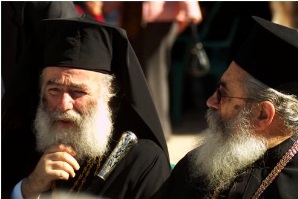 His Beatitude the Patriarch of Alexandria and All Africa Theodoros II (l) and Archbishop Damianos I of Sinai, Pharan and Raitho (r) share a private moment on the Feastday of Saint Catherine in 2005. (Massimo Pizzocaro/Italy)
His Beatitude the Patriarch of Alexandria and All Africa Theodoros II (l) and Archbishop Damianos I of Sinai, Pharan and Raitho (r) share a private moment on the Feastday of Saint Catherine in 2005. (Massimo Pizzocaro/Italy)
Byzantine icons displayed in the narthex welcome pilgrims without fanfare to the world of the legendary Sinai saints – for John Climacus and Gregory of Sinai gazed upon the same sacred images, as did a host of others. They represent the world's foremost collection of Byzantine masterworks, saved by the monks from the destructive centuries of iconoclasm. Preserved by the desert climate, saints’ expressions remain as untouched by the centuries as the rocky wilderness without. Unaccountably, the discs of their golden halos revolve in the light as if to display the reality of immortality; a special effect never reproduced outside Sinai, modern iconographers still search for its secret.
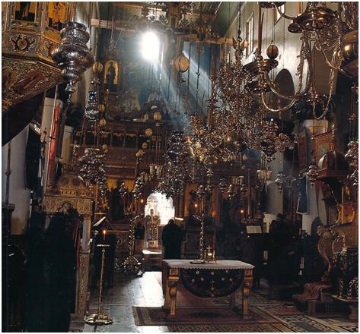 His Eminence Archbishop Damianos I presides over worship from the Royal Doors as light from the Holy Summit of Sinai floods the basilica. (Bruce M. White Photography)
His Eminence Archbishop Damianos I presides over worship from the Royal Doors as light from the Holy Summit of Sinai floods the basilica. (Bruce M. White Photography)
Gifts of European emperors, empresses and kings, they write a compelling history, for the veneration of Saint Catherine took Europe by storm after monks brought miracle-working relics of the saint to Rouen in the eleventh century – the same relics whose incomparable fragrance reaches from their reliquary in the altar to stone passageways about the monastery courtyards.
* * *
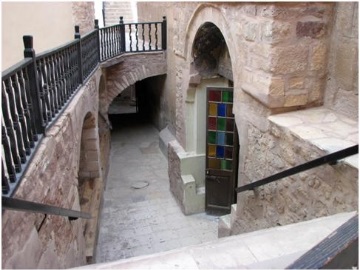 Emperor Justinian’s basilica was not yet built when the 6th century “Piacenza” pilgrim from Italy recounted the hospitable welcome of the Sinai monks during his visit to the Holy Mountain. (Genevieve Angelides)
Emperor Justinian’s basilica was not yet built when the 6th century “Piacenza” pilgrim from Italy recounted the hospitable welcome of the Sinai monks during his visit to the Holy Mountain. (Genevieve Angelides)
Renowned for incomparable beauty, knowledge, and virtue, the young maiden avoided numerous offers of marriage by avowing that no suitor could match her ideals of perfection, drawn as she was to the love of purity in quest of the highest beauty in life.
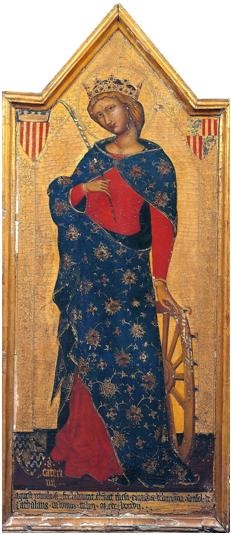 Encompassing over half of the Byzantine icons in existence, the Sinai collections represent every other iconographic stylistic period as well. This portable icon was a gift from Catalonia in 1387, the work of Martin da Vilanova. It is on display in the Monasery Treasury. (Bruce M. White Photography)
Encompassing over half of the Byzantine icons in existence, the Sinai collections represent every other iconographic stylistic period as well. This portable icon was a gift from Catalonia in 1387, the work of Martin da Vilanova. It is on display in the Monasery Treasury. (Bruce M. White Photography)
Returning to the holy elder, Dorothea learned the mysteries of the Faith and was baptized with the name Catherine, or in Greek, Aikaterina. Once again, in a vision she saw the Heavenly Queen with her Divine Child, who this time praised the newly-baptized Catherine’s beauty of soul, saying, "Now she has become brilliant and glorious, noble and wise!"
Taking her hand, the Holy Theotokos said, "Give her a ring, my Child, to make her worthy of Your kingdom," at which the Christ held out a beautiful ring to Catherine, saying, "Behold, today I take you as my pure bride forever – diligently preserve this trust, taking no earthly bridegroom." Catherine awoke from the vision to find the ring on her finger, and her hopes to discover the highest union possible in this life answered.
Consequently, in a unique departure from tradition, the Bride of Christ reigns next to her Bridegroom on the towering iconostasis of her Monastery. Byzantine tradition reserves the place next to Christ for Saint John the Baptist, but in Saint Catherine’s Monastery the friend of the Bridegroom gives way to His bride; the Holy Forerunner moves to the other side of the icon screen, and Saint Catherine takes his place next to Christ.
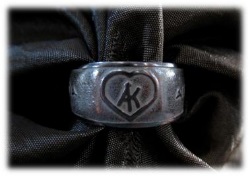 Silver rings bearing the Saint’s monogram are given to pilgrims who hand them down through generations as a perpetual blessing of pilgrimage to Mount Sinai.
Silver rings bearing the Saint’s monogram are given to pilgrims who hand them down through generations as a perpetual blessing of pilgrimage to Mount Sinai.
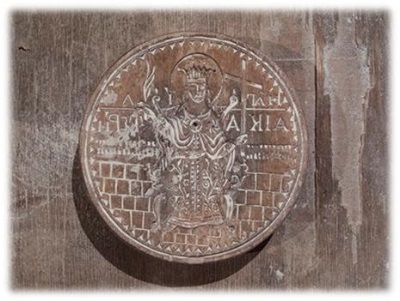 Loaves stamped with the seal of Saint Catherine holding the cross and palm of victory are distributed to pilgrims at the end of the service on the Saint’s Feastday.
Loaves stamped with the seal of Saint Catherine holding the cross and palm of victory are distributed to pilgrims at the end of the service on the Saint’s Feastday.
Enlightened, the scholars confessed Christ, for which they were condemned to be burnt alive on November 17th. Saint Catherine steadfastly withstood all the infuriated emperor’s flatteries, threats, and cruel tortures, including a spiked wheel, which by divine intervention failed to harm her.
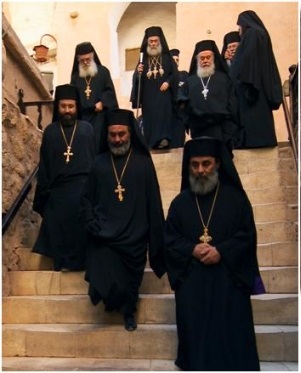 Distinguished guests including Patriarch Theodoros II with Sinai priestmonks enter the church for the Festal Liturgy of Saint Catherine in 2005. (Massimo Pizzocaro/ Italy)
Distinguished guests including Patriarch Theodoros II with Sinai priestmonks enter the church for the Festal Liturgy of Saint Catherine in 2005. (Massimo Pizzocaro/ Italy)
Finally, the Saint was beheaded on November 25th. Angels bore her body to the highest peak in the Sinai range where its presence was miraculously revealed to the monks following construction of their fortress monastery. Monks brought the holy relics of the Great Martyr to the sanctuary of the Monastery where they have exuded unearthly fragrance ever since. As a result of the Saint’s many miracles, the Monastery of the God-trodden Mountain of Sinai gradually became known as St. Catherine's.
* * *
In a chamber hung with ancient tapestries adjacent to the basilica’s main altar, Greek pilgrims wait with anticipation as the moment to venerate the Saint's incorrupt relics finally draws near. Momentarily distracted by an unobstructed view of the famous mosaic Transfiguration of Christ in the high apse over the altar, their attention is recalled by the shimmer of soft bells as a monastery priestmonk begins censing an antique marble sarcophagus, softly chanting theapolytikion of the Saint.
![Recently restored to brilliance by a massive restoration funded by the Emir of Qatar, the Sinai mosaic of the Transfiguration of Christ was described by Kurt Weitzmann as “a vision of Heaven in the wilderness of Moses.”[2]](http://www.pravoslavie.ru/sas/image/102227/222733.b.jpg?mtime=1449437010) Recently restored to brilliance by a massive restoration funded by the Emir of Qatar, the Sinai mosaic of the Transfiguration of Christ was described by Kurt Weitzmann as “a vision of Heaven in the wilderness of Moses.”[2]
Recently restored to brilliance by a massive restoration funded by the Emir of Qatar, the Sinai mosaic of the Transfiguration of Christ was described by Kurt Weitzmann as “a vision of Heaven in the wilderness of Moses.”[2]
Pilgrms approach one by one to kiss the Saint’s precious relics, each with the secret prayer closest to his heart, and then bow to receive the ring blessed by her grace, to be worn forever in mystical union with the Heavenly Bridegroom – and all those illumined by the Holy Light of Sinai to exchange the worship of this world’s false gods for union with the Most High – inspired by the radiant example of our Princess among the Saints, the Holy Great-Martyr and All-Wise Bride of Christ, Catherine of Alexandria.
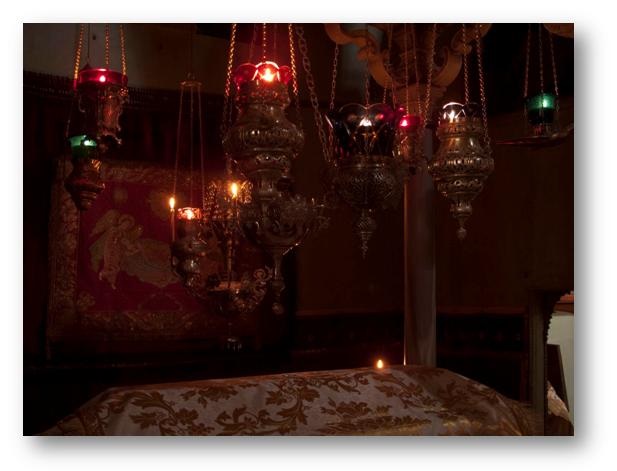 On the Saint Catherine’s feast, all the lamps are lit above the marble reliquary that enshrines her relics, across from a gold-embroidered tapestry depicting angels translating the relics to Sinai.
On the Saint Catherine’s feast, all the lamps are lit above the marble reliquary that enshrines her relics, across from a gold-embroidered tapestry depicting angels translating the relics to Sinai.
 A bluish veil far below the Holy Summit dissolves with the dawn to reveal the crests of a seascape fixed in granite since the blush of creation.
A bluish veil far below the Holy Summit dissolves with the dawn to reveal the crests of a seascape fixed in granite since the blush of creation.

